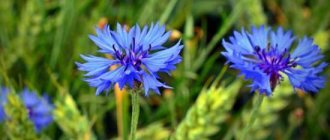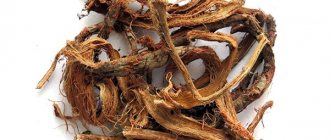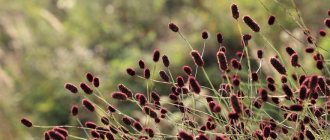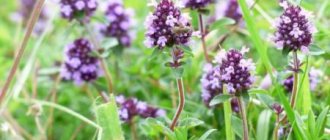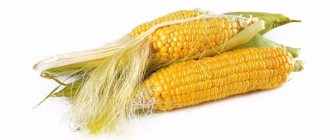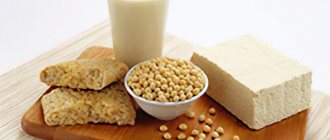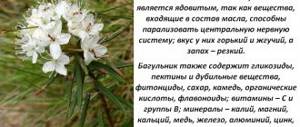Medicinal properties and biochemical composition
The opinion of modern scientists on this issue coincides with the opinion of practitioners of traditional medicine: the medicinal properties of licorice root are very wide and deserve the closest attention.
Licorice gained fame as a legendary healing root due to its unique composition, comparable in value to ginseng root. It, like ginseng, contains a large amount of saponins (about 23%). In addition to their general strengthening effect, they also have an antiallergic effect and also help regulate water-salt metabolism.
Another valuable biologically active compound is flavonoids, which are not produced in the human body. For him, they perform the same mission as for plants - they protect against free radicals that arise under the influence of ultraviolet radiation and radiation. They also protect the tissues of the body’s organs from damage as a result of the release of histamines (substances that arise during inflammatory processes).
The content of glycyrrhizic acid in licorice root provides its antimicrobial and antiparasitic properties. In addition, it has been proven that glycyrrhizin can inhibit the reproduction of viruses (except HIV) .
And some of them, for example, the herpes virus or herpes zoster virus, are completely inactivated in the extracellular state.
Collection and procurement of raw materials
Licorice root is harvested in early spring (March) or late autumn (November). In this case, the plant must be at least 3 years old. The roots are dug up, but about 25% of the rhizomes are left for subsequent restoration of the thicket. Harvesting can be carried out again no earlier than after 6 years.
Licorice roots (separated from the above-ground part) are cleared of soil and washed with cold water. Before drying, they need to be dried for 1–2 days. After this, the roots are cut lengthwise into pieces 30–35 cm long, laid out and dried in the sun or in a dryer.
The raw material is considered dried when the roots break easily when bent. Raw materials can be stored for up to 10 years. To obtain juice, the roots are boiled. It is then dried in a vacuum where it is pressed into licorice or licorice candies.
Application
Having a wide spectrum of action, licorice root is widely used in several areas of modern medicine. This prescription is controlled by the attending physician, taking into account the medicinal properties of this drug and medical contraindications. Indications for use may be as follows, but the spectrum of action is not limited to them:
- atherosclerosis;
- diagnosed infertility;
- viral hepatitis;
- pathologies of the adrenal glands;
- arterial hypertension;
- hormonal imbalance;
- menstrual irregularities;
- herpes;
- cold.
Against cough
Licorice cough syrup is an expectorant that promotes the formation of viscous secretions and the separation of sputum, reduces the intensity of the cough reflex, and soothes unpleasant attacks. Licorice root has a coating effect on the respiratory tract and softens allergic coughs. This prescription is appropriate even for whooping cough with manifestations of dermatitis and pneumonia. Other indications for use are presented below:
- bronchitis;
- laryngitis;
- pharyngitis;
- pneumonia;
- pneumonia;
- tuberculosis.
- What you need to know if you are flying without luggage
- New MTPL tariffs for pensioners
- New benefit for pensioners from August 1 for travel on electric trains
Diseases of the gastrointestinal tract
The enveloping properties of licorice root are appropriate for extensive pathologies of the digestive system, especially relevant for gastritis and stomach ulcers. The medicinal properties of this medicinal plant reduce acidity, normalize intestinal microflora, and stimulate metabolism. Licorice root has medical contraindications, but according to indications it is useful both as a decoction and as an infusion. If you use licorice juice for treatment, it is advisable to dilute it according to the proportions.
For thyroid disorders
In chronic diseases of the endocrine system, there is a hormonal imbalance that requires individual correction. Since the natural composition of licorice rhizomes contains natural hormones - flavonoids and phytoestrogens - their presence is especially valuable for women of reproductive age, helping to cope with diagnosed infertility and other ailments. The main indication for use is hypofunction of the adrenal cortex.
Genitourinary system
Natural licorice tincture is used for diseases of the urinary tract of an infectious-inflammatory nature, for the effective prevention of such. The plant is recommended for acute cystitis and progressive pyelonephritis. The benefits of the herb for the kidneys and liver are obvious, but this medicine is more often recommended as part of a comprehensive treatment regimen.
Joint diseases
This sweet-tasting solution can be used as a powerful pain reliever for joint pain. The medicinal properties of the plant, in the absence of medical contraindications, help to quickly remove inflammation and relieve swelling, and restore the former mobility of the joints. This medicinal plant is recommended for arthritis, arthrosis, rheumatism, polyarthritis and other joint ailments that can lead to disability.
Nervous system
The beneficial rhizome not only productively stabilizes blood pressure, but also acts as a powerful antidepressant. Its medicinal properties are used to increase the tone of the structural elements of the central nervous system, normalize the sleep phase, and eliminate attacks of chronic fatigue and depression. The drug acts quickly and purposefully, so even a child with emotional instability can take it.
Lymph cleansing
This is an effective remedy for lymphostasis, since it productively cleanses blood and other biological fluids of intoxication products. For example, a decoction of licorice root can remove toxins from the surface of the skin and stimulate metabolic processes at the cellular level. However, before using the medicinal properties of the plant, it is recommended to familiarize yourself with medical contraindications.
- Zucchini in a slow cooker
- Which food combinations increase the risk of dementia?
- Retirement age for men - changes in the new bill and who concerns
Use of licorice root for medicinal purposes
The most common and most common indication for the use of licorice extract is respiratory diseases - laryngitis, bronchitis, pneumonia and even tuberculosis.
The product effectively increases sputum production, relieves dry, painful coughs and helps accelerate the elimination of germs.
Licorice root syrup
Official medicine has also recognized the effectiveness of licorice. Therefore, pharmacies widely offer industrial preparations - licorice root for coughs and colds in syrup. It is worth noting that licorice syrup received excellent recommendations from pediatricians.
They prescribe this drug to children, even in the first weeks of their life. This is a universal remedy for the treatment of cough in infants, as well as diseases of the gastrointestinal tract, and is an antipyretic. Licorice root is a truly natural product that is not scary to give to your baby, worrying that it contains a large amount of harmful substances.
You can easily make your own licorice root syrup at home. This syrup is especially convenient to give to young children - it has a pleasant sweetish taste, and kids accept it without negative emotions.
To prepare syrup at home, you need a certain amount of ingredients: licorice root (5 grams), sugar syrup 80 grams and medical alcohol 10-12 grams.
All components are mixed sequentially: the extract is added to the syrup, and alcohol is poured into the resulting mixture. This syrup should be stored in the refrigerator in a tightly closed container (jar or bottle). It is used to treat colds (especially coughs).
Homemade cough tincture made from licorice and white wine
To be able to get all the benefits from the magic root, you should prepare a homemade cough tincture: finely chopped fresh licorice root, pour 0.5 liters of dry white wine and let it brew for 10 days. Take 30 drops 2 times a day with water.
Recipe for heartburn and stomach pain
The second traditional reason for using this plant is the treatment of digestive disorders. When it is necessary to relieve heartburn or relieve pain in the stomach , it is recommended to prepare tea according to the following recipe: 2 tsp. licorice mixed with 1 tsp. lemon balm and 1 tsp. chamomile, brew with 1 glass of boiling water, let it brew for 15 minutes and drink after eating.
Licorice root for constipation
If a person is faced with such an unpleasant phenomenon as constipation, then a sweet medicine will also help cope with it: mix 20 g of dry licorice root with 5 g of ground dill seeds; brew 1 tbsp. l. the resulting mixture with 1 cup of boiling water and wrap to infuse. It is recommended to consume it 0.5 cups 1 hour after meals.
Other uses
Traditional medicine has long used licorice root treatment for snake and insect bites as an antidote, as well as food and medicinal poisoning..
In addition, licorice preparations are effective for relieving inflammation of various locations and origins. For joint diseases - rheumatism, arthritis, arthrosis - taking a herbal infusion based on licorice will quickly bring relief.
A decoction of licorice roots helps with chronic fatigue, rapid fatigue, restores the functioning of the nervous system, and normalizes sleep. A decoction of the roots of the plant, prepared with milk, is useful for children with whooping cough. For dry throat, laryngitis, and pharyngitis, the root should be chewed.
Provided that the prepared infusions do not contain industrial sugar, extracts and teas from licorice root are recommended for consumption by people with diabetes. These products have a low glycemic index, that is, they do not increase the amount of sugar in the blood. Moreover, some substances contained in licorice help reduce it, that is, it can be argued that taking licorice improves the quality of treatment for type II diabetes.
Recipes for preparing medicines
Licorice root can be taken in any form. At home, medicinal water tinctures, decoctions and syrups are prepared from it, the effect of which will be almost the same.
- To prepare the tincture, fry 2 teaspoons of roots in a frying pan and pour two glasses of boiling water over them. Leave for 6-8 hours to infuse. After the required time, the medicine will be ready for use.
- To make a decoction, pour ¾ tablespoon of root with a glass of boiling water, keep them in a water bath for 20 minutes and leave to infuse for 40 minutes. Then we filter the broth, after which it is ready for use.
- To prepare the syrup, mix 80 g of sugar. 4 g licorice extract and 10 g alcohol.
Another treatment option using the root is a foam-licorice bath, which has an immunostimulating effect. Thanks to this effect, baths are an effective way to treat cancer. When using it, the patient is immersed in a thick, soft foam made from licorice root extract.
Licorice root in cosmetology
Licorice root is included in almost all face creams in the “anti-aging” program. The rejuvenating and whitening effect of the plant is used.
Licorice root is used for facial skin prone to pimples, rashes, irritations and acne. In this case, its anti-inflammatory, anti-allergic and regenerating properties act.
Licorice root for hair is an effective remedy against hair loss, split ends and hair weakness. It is also suitable for thin, damaged, dyed hair, as it has not only a healing effect, but also an enveloping effect.
Chemical composition of medicinal raw materials
Several groups of biologically active substances have been found in the licorice root. In terms of the qualitative composition of flavonoids, the licorice rhizome has no equal - more than 30 flavonoid compounds were found in it, which suggests the versatility of the medicinal plant.
In addition to flavonoids, licorice rhizome contains up to 20% mono- and disaccharides, starch, pectin compounds, vitamins, mucous substances, etc. Of particular value is glycyrrhizin, a non-sugar compound with a triterpene structure, due to which licorice rhizome has a sickly sweet taste.
Licorice root for weight loss
A very pleasant side effect of regular consumption of licorice root is the reduction of fat deposits and the prohibition of their new deposition. Along with a positive change in body mass index, a decrease in blood cholesterol levels is also observed.
All this allows you to normalize your metabolism, and together with the digestive benefits of licorice, it can significantly affect your figure. Although you should not use licorice root powder solely for the purpose of losing weight, since this herbal product has a whole range of side effects and contraindications.
Be careful - there are restrictions!
Of course, any person may have a question: does licorice root have contraindications, and if so, what are they? Indeed, long-term use of any plant internally has its limitations. Yellow root is no exception. Therefore, people of the following categories should treat various infusions from it with extreme caution, even to the point of complete refusal:
- having persistent high blood pressure (hypertension);
- prone to swelling of the body;
- those suffering from acute hepatitis and cirrhosis of the liver;
- taking various diuretics and drugs against heart failure.
It is absolutely not recommended to eat licorice root during pregnancy for the purpose of treatment or prevention, as it can cause complications. The maximum amount of licorice tea for children is no more than half a glass once a day. In any case, if in doubt, you should consult a doctor.
Licorice for women
Licorice root has antispasmodic, anti-inflammatory and mild estrogenic effects that help relieve PMS symptoms: mood swings, breast tenderness, nausea and bloating, and menstrual cramps. To alleviate the condition, you need to use licorice root tea, starting three days before the expected start of the period. This will help relieve menstrual cramps and relieve PMS symptoms.
The phytoestrogens and antioxidants contained in licorice are considered beneficial in treating hormonal disorders: fatigue, mood swings, hot flashes and in menopausal women.
♦ Infertility. We take a collection of equal parts of licorice, agrimony, meadowsweet, sage, yarrow, knotweed, centaury, nettle, mistletoe, horsetail, elecampane, wormwood and sea buckthorn. A tablespoon of the mixture is poured with 300 grams of boiling water and simmered for five minutes.
♦ Uterine cancer. For uterine cancer, you can try the following recipe. You need to take ten grams of licorice and motherwort, forty grams of celandine, agrimony, string, yarrow and St. John's wort, twenty grams of burdock root, chamomile, thyme and dandelion, thirty grams of plantain and immortelle and five grams of valerian. One tablespoon of the collection is brewed in a glass of boiling water and simmered over low heat for a couple of minutes, after which it is drunk in several doses throughout the day. The course of treatment is three months.
Contraindications to the use of licorice preparations
Smooth licorice preparations are not recommended for self-medication, as they have a number of contraindications for use:
– Liquorice is often used to improve the taste of medicinal products, however, some patients may have an individual intolerance, symptomatically manifested in the form of nausea. In this case, the licorice powder must be fried in a hot frying pan for some time.
– Licorice root preparations increase blood pressure, which must be taken into account when treating patients with obvious signs of hypertension.
– Liquorice is contraindicated in certain inflammatory liver diseases, cirrhosis.
– During pregnancy and breastfeeding, licorice preparations are not prescribed.
– Licorice preparations have an effect on various organs, so excessive dosages and uncontrolled use of licorice can provoke the appearance of edema, menstrual irregularities, etc. If it is necessary to prescribe excessive dosages, treatment is carried out for no longer than 6 weeks. In this case, potassium supplementation of the body (dried apricots, bananas) is required.
Particular attention should be paid to the combined use of licorice preparations with other medicinal products:
– Long-term combined use with diuretics causes potassium starvation (hypokalemia).
– An unfavorable combination of licorice preparations with drugs for the treatment of heart failure - there is a high risk of arrhythmia.
Reviews
Licorice syrup is a sweet and tasty medicine, unlike other medicines. It always helps to cure the throat if it is inflamed and sore, removes phlegm and is inexpensive. I give it to my six year old son when he has a cold and starts coughing. The symptoms go away quite quickly. Redness disappears two days after use. Now doctors are trying to prescribe more expensive products, so I buy them myself, without prescriptions. Moreover, the drug is available without a doctor’s prescription.
Svetlana, 32 years old, Mozhaisk
I always have this syrup in my medicine cabinet. It is inexpensive and helps better than expensive imported drugs. By the way, I noticed that foreign herbal-based drugs are very expensive. More expensive than chemical-based drugs. And our herbal medicines cost a penny, but are not popular. Because people have this idea: the more expensive the drug, the more effective it is. But this is far from true; licorice is a very effective medicine. When treating bronchitis, phlegm is intensively removed from the lungs, and the antibacterial effect helps heal the throat. So buy our drugs, they treat no worse than imported ones.
Marina, 43 years old, Moscow
I used syrup to remove freckles. In the spring my face is always covered with them. My grandmother recommended this drug to me. She also used it in her youth and praised it. I tried it 5 years ago and now I use it all the time. I smeared the syrup on my face for about 10 minutes for two weeks, morning and evening before bed. At first the effect was not noticeable, but then the spots began to fade and eventually disappeared completely. Even in the scorching sun they no longer appear. But every spring the procedure must be repeated. Since after winter the skin turns pale, and the effects of the sun immediately affect the face.
Galina, 20 years old, Lipetsk
I have red hair and had freckles on my face throughout my childhood. Because of this, I always had a lot of complexes. I tried a lot of remedies: expensive lotions, and juices of various plants, but nothing helped until the doctor advised me to use licorice root. He told me the recipe. I prepared it out of desperation and wiped it on my face 3 times a day for a week. The freckles have faded so much that if you don’t look closely, you won’t notice their presence. Now, when these hated stains appear, I prepare a solution and immediately get rid of them.
Dmitry, 22 years old, Voronezh
Licorice root syrup is a herbal preparation with an expectorant effect.
Release form and composition
The dosage form is syrup: thick, brown in color, with a sweet taste and a peculiar smell (in bottles of 100 g, 1 bottle in a cardboard box).
Composition of 100 mg syrup:
- active ingredient: thick licorice root extract – 4 mg;
- auxiliary components: sugar syrup – 86 mg; 95% ethanol – 8.7 mg; purified water – up to 100 mg.
Pharmacological properties
Pharmacodynamics
Licorice root syrup has an expectorant effect, which is mainly due to glycyrrhizin, which leads to increased secretory function of the mucous membranes of the upper respiratory tract.
Indications for use
Licorice root syrup is prescribed as an expectorant in the treatment of diseases of the upper respiratory tract that occur with cough, mainly in the presence of poorly discharged, viscous and thick secretions, especially in children and elderly patients.
Contraindications
Absolute:
- bronchial asthma;
- gastritis;
- exacerbation of peptic ulcer of the stomach and duodenum;
- fructose intolerance, sucrase/isomaltase deficiency, glucose-galactose malabsorption;
- pregnancy and breastfeeding;
- individual intolerance to the components of the drug.
Relative (diseases/conditions in which the use of Licorice root syrup requires caution):
- liver diseases;
- traumatic brain injuries;
- alcoholism;
- diabetes;
- brain diseases;
- childhood.
Instructions for use of Licorice root syrup: method and dosage
The drug is taken orally.
Recommended single dose of Licorice root syrup for children (with a dosage frequency of 3 times a day):
- children under 2 years old: 1–2 drops (after preliminary dilution in 1 teaspoon of water);
- children 2–6 years old: 2–10 drops (after preliminary dilution in 1 teaspoon of water);
- children 6–12 years old: 50 drops (after preliminary dilution in 1/4 glass of water);
- children over 12 years old: 1/2 teaspoon (after preliminary dilution in 1/4 glass of water).
The recommended single dose of syrup for adults is 1 teaspoon (after preliminary dilution in 1/2 glass of water) 3 times a day.
Duration of use is from 7 to 10 days. The need for a longer course should be discussed with your doctor.
To facilitate expectoration in the presence of poorly separated sputum, it is recommended to drink plenty of warm fluids.
Side effects
Allergic reactions are possible when using Licorice root syrup.
In some cases, dyspeptic symptoms (in the form of diarrhea) may develop.
When taking a long course, the following adverse reactions are possible: hypokalemia, increased blood pressure, peripheral edema associated with impaired water-electrolyte metabolism.
Overdose
Main symptoms: increased dose-dependent side effects.
Therapy: symptomatic.
special instructions
1 drop of syrup contains 0.01 XE, 1 teaspoon contains 0.11 XE.
The maximum adult single dose is 430 mg of absolute alcohol, 1 drop is 19 mg.
Use during pregnancy and lactation
According to the instructions, licorice root syrup is contraindicated during pregnancy and lactation.
Use in childhood
Prescribing Licorice Root Syrup for children requires caution.
For liver dysfunction
Patients with liver disease should administer licorice root syrup with caution.
Drug interactions
Possible combined use with other drugs used for the treatment of bronchopulmonary diseases.
Concomitant use with drugs containing codeine, as well as with other drugs with antitussive effects, is not recommended, as this may lead to difficulty coughing up liquefied sputum.
Analogs
Analogs of Licorice root syrup are Licorice thick extract, Licorice roots, Coughstops, Licorice syrup with elderberry for wet cough, Coughstops.
Terms and conditions of storage
Store in a place protected from light at temperatures up to 20 °C. Keep away from children.
Shelf life – 2 years.
Conditions for dispensing from pharmacies
Available without a prescription.
Reviews of Licorice root syrup
According to reviews, Licorice root syrup is an inexpensive, natural and effective cough treatment. One of its advantages is that it can be used by patients of all ages. However, it is necessary to take into account that the drug contains alcohol.
Not everyone likes the overly sweet taste of syrup. It is also noted that the drug has a therapeutic effect when taken at the onset of the disease.
Price for Licorice root syrup in pharmacies
The approximate price for Licorice root syrup (100 g per package) is 30 rubles.
Pharmacology
Herbal product. Licorice root contains glycyrrhizin (from 6 to 12%), glycyrrhizic acid and its salts, flavone glycosides (liquiritin, liquiritigenin, liquiritoside), isoflavonoids (formononetin, glabrene, glabridin, glabrol, 3-hydroxyglabrol, glycyrrhizoflavone), coumestan derivatives (glycyrol, isoglycerol, liquocoumarin), hydroxycoumarins (including herniarin, umbelliferone, glycocoumarin, lycopyranocoumarin), steroids (sterols, including beta-sitosterol, sigmasterol), essential oils (in small quantities).
Glycyrrhizin stimulates the activity of the ciliated epithelium and enhances the secretory function of the mucous membranes of the upper respiratory tract, facilitating expectoration. It has antiulcer and anti-inflammatory effects, reduces platelet aggregation.
Licorice inhibits the enzyme 11-beta-hydroxysteroid dehydrogenase in the kidneys, which leads to a decrease in the conversion of cortisol to cortisone. The mineralocorticoid activity of cortisol causes a decrease in the concentration of potassium in the blood serum and an increase in sodium content, which leads to fluid retention in the body, weight gain and arterial hypertension. Glycyrrhizic acid and its metabolites inhibit the peripheral metabolism of cortisol and cause a pseudoaldosterone-like effect.
Liquiritoside has an antispasmodic effect on smooth muscles.
Release form
| Syrup | 100 g |
| licorice root extract (licorice glabra and licorice Ural roots with underground shoots) | 4 g |
100 g - orange glass bottles (1) - cardboard packs.
Dosage
The prepared infusion (10-15 g of raw material per 200 ml of water) is taken orally, 1 tablespoon 3-5 times a day.
Interaction
Concomitant use of thiazide diuretics with licorice is not recommended due to the risk of hypokalemia.
Hypokalemia caused by long-term use of licorice can potentiate the toxic effect of cardiac glycosides.
With the simultaneous use of licorice and corticosteroids, an increase in the half-life of cortisol is possible.
Side effects
Possible: with prolonged use of licorice preparations - increased blood pressure, the appearance of edema, disorders of the reproductive system.
Indications
Diseases of the upper respiratory tract, lungs; hyperacid gastritis, peptic ulcer of the stomach and duodenum. Addison's disease, hypofunction of the adrenal cortex (as part of complex therapy).
Contraindications
Chronic hepatitis, liver disease with cholestasis, liver cirrhosis, severe renal failure, diabetes mellitus, heart rhythm disturbances, arterial hypertension, hypokalemia, pregnancy, hypersensitivity to licorice.
special instructions
Use during pregnancy and breastfeeding
Licorice preparations are contraindicated for use during pregnancy.
Use for liver dysfunction
Contraindicated in chronic hepatitis, liver diseases with cholestasis, liver cirrhosis.
Use for renal impairment
Contraindicated in severe renal failure.
special instructions
With long-term use, hypokalemia, hypernatremia, edema, arterial hypertension, and functional disorders of the heart are possible.
The issue of choosing an effective cough medicine is very important for parents, since diseases of the respiratory system are quite common in children. If we are talking about treating a child, then among the many remedies that help relieve coughs and improve phlegm removal, herbal preparations are in greatest demand.
They contain herbs and plant extracts, so they are considered safer for children's bodies. One of these remedies is licorice-based medicines. What are they and how do they affect the patient’s body?
Useful properties of licorice
The roots of this legume plant, also called licorice, contain many active substances. It is thanks to isoflavonoids, essential oils, gricyrrhizin, flavone glycosides, polysaccharides and glycyrrhizic acid that preparations that contain extract from licorice roots:
- stimulate the secretory function of the bronchi;
- eliminate spasm of the muscles of the bronchial tree;
- activate the work of the epithelium of the respiratory tract;
- help thin mucus in the bronchi.
Licorice not only has an expectorant effect, but also has some anti-inflammatory effects, affects microbes (mainly staphylococci) and viruses in the respiratory system, accelerates the healing of the mucous membrane and stimulates the body's defenses (useful for strengthening the immune system). The active substances of this plant also have laxative, diuretic, antiulcer and antitumor properties.
Release forms
Preparations in which active substances from licorice are the main active ingredient are presented:
- Powdered licorice root , packaged in packs of 35, 40, 50, 75 and 100 grams of plant material. Some manufacturers offer crushed roots in filter bags of 1.5 or 2 grams, packed in boxes of 10-20 pieces. The crushed licorice root has a grayish-yellow color and a peculiar smell, and after brewing with water, a sweetish liquid is formed. The use of this drug in children is allowed from 1 year.
- Licorice root syrup. It is sold in glass bottles containing 100 grams of a syrupy, sweet, brown liquid. One bottle contains 4 grams of thick extract from licorice roots, supplemented with ethyl alcohol and sugar syrup. Some manufacturers' products may also contain citric acid, glycerin, preservatives and other compounds.
Such syrups are also allowed for children over one year of age, but due to the presence of an alcoholic component in the medicine, it is recommended to give the medicine to a child under 12 years of age only as prescribed by a doctor.
In addition, licorice extract is included in various dietary supplements and multicomponent medicines with an expectorant effect. These include the following:
- "Linkas". This preparation includes extracts from several plants, including marshmallow, violet, jujube, alpinia, licorice and others. It is available in syrup form and is used in children over 6 months of age.
- "Breast collection No. 2." In this herbal remedy, plantain and coltsfoot leaves are added to licorice roots. This collection is brewed with boiling water and given to children over 12 years of age to drink.
- "Amtersol". This syrup has an expectorant effect thanks to extracts from thermopsis and licorice, as well as ammonium chloride, sodium benzonate and potassium bromide. It is prescribed to children over 3 years of age.
- "Breast Elixir" . This product contains anise oil and ammonia solution added to a thick licorice extract. In childhood, it is used with caution and only as prescribed by a pediatrician.
- "Doctor Mom" This syrup includes extracts from ten medicinal plants and levomenthol. It has not only an expectorant, but also a bronchodilator effect. This drug is prescribed to children from the age of three.
- Codelac Phyto. The basis of this drug in the form of an elixir is codeine, supplemented with plant extracts (in addition to licorice, the medicine includes thyme and thermopsis). The medication is in demand for coughs from the age of 2 years.
- "Dry cough medicine for children" . This medicine is produced in bags or bottles, inside of which there are dry extracts from marshmallow and licorice roots, as well as anise oil, ammonium chloride and some other components. A doctor can prescribe this medicine at any age.
- "Suprima-Broncho". This syrup helps against coughs thanks to the active substances from turmeric, basil, adatoda, nightshade, licorice, ginger and other medicinal plants. It is prescribed to children from the age of three.
Indications
Preparations containing licorice are most in demand for wet coughs, when the secretion formed by the cells of the bronchi is too thick and viscous, which prevents normal coughing. The medication is used for laryngitis, bronchitis, tracheitis, pneumonia and other diseases of the respiratory system. In addition, an extract from licorice roots can be prescribed for hyperacid gastritis and ulcerative lesions of the gastrointestinal tract.
Contraindications
All drugs with licorice should not be given in case of hypersensitivity, exacerbation of gastritis, arrhythmias, bronchial asthma, high blood pressure, kidney disease or serious liver pathologies.
Licorice extract syrup should not be used in children with diabetes.
Side effect
Some patients react to medications with licorice nausea, skin redness, diarrhea, itching, rashes, or other signs of intolerance, requiring discontinuation of the drug. Too much treatment with licorice root extract or an overdose of such a remedy can cause swelling and high blood pressure.
Instructions for use
If plant materials are used, an infusion should be prepared from it. The cooking method is usually indicated on the box. To make a decoction correctly, take 8-10 g of crushed roots or one filter bag per 200 ml of boiled water. Cover the roots with boiling water and leave them for 30-60 minutes. After straining the finished drink or squeezing out the bag, you need to add water so that the total volume of the tincture is 200 ml.
You need to take this remedy two to four times a day, and the single dosage should be checked with your doctor. Usually, a one-year-old child is given the infusion one teaspoon, small patients over 3 years old - a dessert spoon, and from the age of 12 - a tablespoon. The duration of treatment with this drug is often 2-3 weeks.
Syrup made from licorice roots is given to children after meals, diluted with non-hot boiled water. The bottle of medicine is shaken, and then the required dose of syrup is dropped into a spoon or glass of water, after which it is offered to the patient. A child 1-2 years old is given 1-2 drops of the drug per dose, a patient 2-6 years old needs to dilute 2-10 drops in a spoon of water, and from the age of seven the medication is given 1/2-1 teaspoon.
Typically, this drug is taken three times, and the average duration of therapy is 7-10 days.
Purchase and storage
Purchasing crushed licorice roots or a syrup made from them in a pharmacy does not cause difficulties, since these products are over-the-counter. The cost of these drugs is low and depends on both the type of drug and the manufacturer. On average, you need to pay 20 rubles for a bottle of syrup, and 30-40 rubles for 50 g of crushed roots.
The shelf life of herbal raw materials is usually 2-3 years, and the prepared infusion can be stored for 48 hours by placing it in a cool place. Depending on the manufacturer, the syrup is good for 2 or 3 years from the date of manufacture. Until the date marked on the bottle has passed, the sweet preparation should be stored in a place inaccessible to sunlight at a temperature not exceeding 25 degrees Celsius.
Reviews
The use of licorice-based medicines for coughs in children is generally well received. The main advantages of these drugs for mothers include a herbal base, low price and effective effect on the respiratory system. The syrup is praised for its sweet taste, enveloping effect and ease of dosing.
The disadvantages of this product usually include alcohol and sugar in the composition (because of this, many parents prefer to brew the crushed root), as well as contraindications. In addition, some children experience allergies after using the syrup.
Analogs
Instead of drugs based on licorice roots, children may be prescribed other herbal medicines that have a similar effect on the respiratory tract. These include:
- "Marshmallow syrup";
- "Gedelix";
- "Bronchicum S";
- "Doctor Theiss";
- "Prospan";
- "Bronchipret";
- "Eucabalus";
- "Travisil";
- "Gerbion" and other medicines.
Such products contain extracts from various plants that help thin mucus and make it easier to cough up. However, each of them has its own contraindications (including age restrictions), so to choose an analogue you should consult a doctor. In addition, the doctor may recommend expectorants without a herbal base, for example, one of the drugs ambroxol or bromhexine.
In addition, in many cases, expectorant medication alone is not enough, and based on the results of the examination, the child is prescribed other medications, in particular antibiotics. That is why it is not advisable to buy syrup, lozenges, mixture or other medicine for a coughing child without first examining a doctor.
For information about the beneficial properties of licorice root and contraindications, see the following video.
Source: help-prostata.ru
Drug interactions
The use of syrup with the following groups of drugs is contraindicated.
- The use of licorice root is not recommended concomitantly with thiazide diuretics due to the risk of hypokalemia.
- When taking syrup and corticosteroids simultaneously, the time for cortisone elimination will increase.
If symptoms of hypokalemia appear while using the drug: chest pain or changes in heart rate, you should stop taking it and consult a doctor.
Release form and composition
Like any medicine, licorice root syrup has main and auxiliary active ingredients. 100 grams of product contains:
- thick licorice extract - 4 grams;
- sugar syrup - 86 grams;
- ethyl alcohol (ethanol) - 10 grams.
The drug is made in the form of a dark brown syrup for internal use. The active ingredient is extract of licorice glabra rhizomes. The roots contain glycyrrizzic acid, coumarin, flavonoids, essential oil, sugars.
The syrup is produced in brown bottles of 100 milliliters. There are many manufacturers of this medicine, the packaging is also different, but the composition is the same. The amount of the drug may vary from different manufacturers.
Contraindications
Despite the wide list of positive properties, licorice root should be consumed taking into account certain rules:
- no more than 6 weeks in a row - the product accumulates in the body, after the end of use it will be excreted from the tissues for several months;
- an overdose can cause severe headaches, prolonged migraines, turning into a complex form of depression;
- if you abuse licorice, you can get disturbances in the functioning of the cardiovascular system, breathing becomes difficult, and shortness of breath appears;
- Pregnant, breastfeeding mothers and children under 3 years of age are not recommended to use the drug or only under the strict supervision of a doctor;
- in the presence of hypertension, disorders of the kidneys and liver, it is contraindicated to use the healing composition independently, without consulting a specialist;
- Long-term use of the drug removes potassium from the body, therefore, throughout the entire period of treatment with a natural component, you need to eat properly, especially choose foods rich in potassium.

